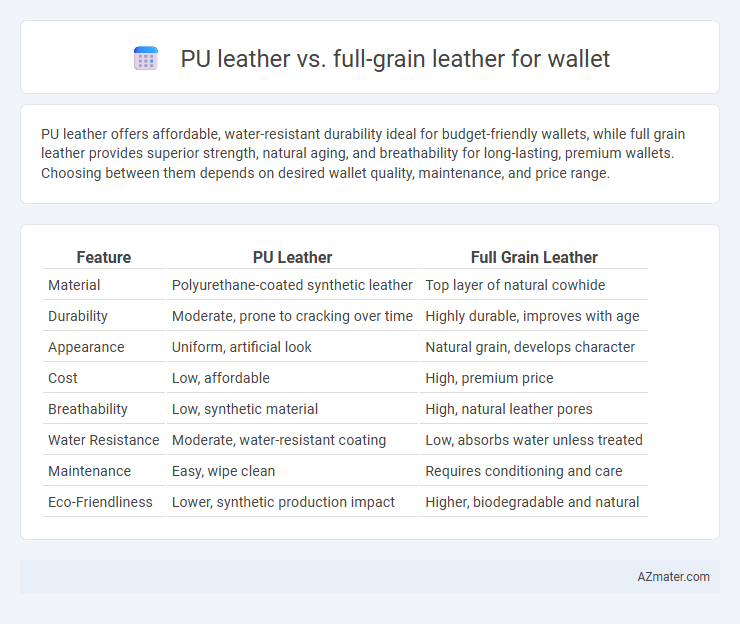PU leather offers affordable, water-resistant durability ideal for budget-friendly wallets, while full grain leather provides superior strength, natural aging, and breathability for long-lasting, premium wallets. Choosing between them depends on desired wallet quality, maintenance, and price range.
Table of Comparison
| Feature | PU Leather | Full Grain Leather |
|---|---|---|
| Material | Polyurethane-coated synthetic leather | Top layer of natural cowhide |
| Durability | Moderate, prone to cracking over time | Highly durable, improves with age |
| Appearance | Uniform, artificial look | Natural grain, develops character |
| Cost | Low, affordable | High, premium price |
| Breathability | Low, synthetic material | High, natural leather pores |
| Water Resistance | Moderate, water-resistant coating | Low, absorbs water unless treated |
| Maintenance | Easy, wipe clean | Requires conditioning and care |
| Eco-Friendliness | Lower, synthetic production impact | Higher, biodegradable and natural |
Introduction to PU Leather and Full Grain Leather
PU leather, a synthetic material crafted by coating a fabric base with polyurethane, offers affordability, water resistance, and ease of maintenance, making it a popular choice for wallets. Full grain leather, derived from the top layer of animal hide, retains natural markings and develops a rich patina over time, representing premium quality and durability in wallet craftsmanship. Both materials cater to different preferences, with PU leather focusing on cost-effective and vegan alternatives, while full grain leather excels in longevity and classic aesthetics.
What is PU Leather?
PU leather, or polyurethane leather, is a synthetic material made by coating a base fabric with a flexible polymer and then embossing it to resemble natural leather. It offers a cost-effective, water-resistant, and animal-friendly alternative to genuine leather, commonly used in wallet manufacturing for its durability and easy maintenance. Unlike full grain leather, PU leather lacks the natural texture and develops less character over time, making it ideal for consumers seeking affordable and stylish wallet options without compromising on appearance.
What is Full Grain Leather?
Full grain leather is the highest quality leather made from the top layer of the animal hide, retaining its natural grain and imperfections, which contribute to its durability and unique patina over time. Unlike PU leather, which is a synthetic material made by coating fabric with polyurethane, full grain leather offers superior breathability, strength, and aging characteristics, making it ideal for premium wallets. The natural texture and resilience of full grain leather ensure that wallets develop a personalized look with use, enhancing their value and longevity compared to PU leather alternatives.
Durability: PU Leather vs Full Grain Leather
Full grain leather offers superior durability for wallets due to its natural fiber strength and resistance to wear, developing a unique patina over time. PU leather, crafted from synthetic materials, tends to wear out faster, peeling and cracking with frequent use. For long-lasting wallet performance, full grain leather is preferred over PU leather.
Appearance and Texture Differences
PU leather offers a consistent, smooth surface with a uniform texture that mimics genuine leather but often lacks the natural grain variations found in full grain leather. Full grain leather displays rich, authentic patterns with natural imperfections that enhance its uniqueness and develop a patina over time, providing a more luxurious and tactile experience. The texture of full grain leather feels supple and breathable, while PU leather may feel stiffer and less porous, impacting both comfort and durability in wallets.
Cost Comparison: PU Leather vs Full Grain Leather
PU leather wallets generally cost significantly less than full grain leather wallets due to the synthetic materials and lower production expenses involved. Full grain leather wallets command higher prices reflecting the premium quality, durability, and natural characteristics of genuine leather. Consumers often weigh the affordability of PU leather against the long-term value and aging properties offered by full grain leather in wallet purchases.
Environmental Impact and Sustainability
PU leather, a synthetic material made from polyurethane, has a lower immediate environmental impact in terms of animal welfare but relies heavily on fossil fuels and non-biodegradable chemicals, raising concerns about long-term sustainability and microplastic pollution. Full grain leather, derived from the top layer of animal hides, is biodegradable and often considered more durable, which can extend product life and reduce waste, yet its production involves significant water consumption, tannins, and greenhouse gas emissions. Sustainable wallet choices balance durability, biodegradability, and resource consumption, suggesting full grain leather with responsible tanning processes as a more eco-conscious option compared to PU leather's synthetic drawbacks.
Maintenance and Care Requirements
PU leather wallets require minimal maintenance, typically needing only regular wiping with a damp cloth to remove dirt and prevent cracking. Full grain leather wallets demand more intensive care, including periodic conditioning with leather oils or creams to maintain suppleness and protect against moisture and stains. Proper storage away from direct sunlight and heat is essential for full grain leather to prevent drying and discoloration.
Pros and Cons of PU Leather Wallets
PU leather wallets offer affordability and a wide range of colors and textures, making them a popular choice for budget-conscious consumers. However, PU leather lacks the durability and breathability of full grain leather, often resulting in quicker wear and less resistance to scratches and moisture. While easy to maintain and water-resistant, PU leather wallets do not develop the unique patina that enhances the character and longevity of full grain leather products.
Pros and Cons of Full Grain Leather Wallets
Full grain leather wallets offer exceptional durability and develop a unique patina over time, enhancing their aesthetic appeal and longevity. They resist wear and tear better than PU leather, making them ideal for users seeking long-term investment in quality accessories. However, full grain leather wallets tend to be more expensive and require regular maintenance to preserve their texture and prevent damage from moisture.

Infographic: PU leather vs Full grain leather for Wallet
 azmater.com
azmater.com